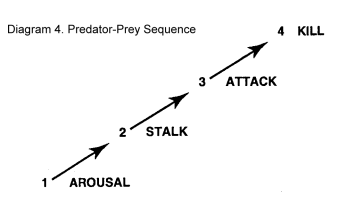The Human Nature of Violence
— By Robin Fox
Part 4.
It is important to note that we are talking here of a fight sequence between conspecifics of the same group - these animals know each other and know the rules, as it were. Between conspecifics of different groups this might be a much shorter and more bloody sequence. As Schaller said of a male lion who strayed into the territory of another lion pride, the only ritualization open to him is to run like hell. Also, this kind of "violence" has to be clearly distinguished from predatory violence between predator and prey species, where the sequence is as in diagram 4: the "stalk-attack-kill" sequence. Here the purpose of the encounter is the killing for food, and it is not drawn out. The predator gets on with the job. But that is why the elaborate sequences of escalation and de-escalation among familiar conspecifics are so interesting: there is ample opportunity to break off or de-escalate before getting to the killing or wounding point. And as the ethologists have demonstrated in species after species, the vast majority of fighting stops at the ritual level.
It has been my contention for many years that the vast majority of human violence is of this kind also. It goes on all the time but usually rumbles away at the lower levels of escalation. We waste our time asking what "causes" it: it is as much a part of the human life process as digesting or reproducing. Flirting goes on all the time also, and sometimes escalates to a higher level of sexual activity, and no one asks what causes that. We are a sexually reproducing, sexually competitive, slow-growing, large land mammal. At puberty, our males, for example, increase their testosterone levels as much as ten to thirty times. Given sexual competition, the dominance of older males, and the rise in testosterone, it is entirely predictable that violence will occur. Thus, we find in all cultures young, postpubescent males acting aggressively, and older males acting to restrain and divert them. The females, in their wisdom, pick off the winners. This is what Darwin called sexual selection.


